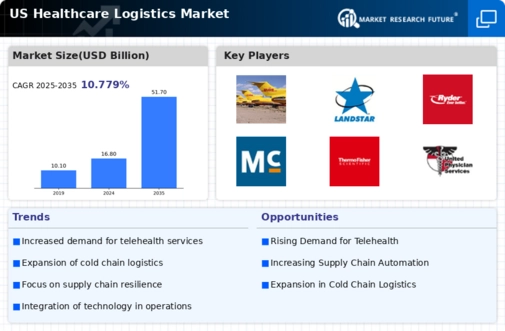The healthcare logistics market is characterized by a dynamic competitive landscape, driven by the increasing demand for efficient supply chain solutions and the need for enhanced patient care. Key players such as McKesson Corporation (US), Cardinal Health, Inc. (US), and AmerisourceBergen Corporation (US) are at the forefront, each adopting distinct strategies to solidify their market positions. McKesson Corporation (US) focuses on digital transformation and technology integration, aiming to streamline operations and improve service delivery. Cardinal Health, Inc. (US) emphasizes partnerships and collaborations to expand its service offerings, while AmerisourceBergen Corporation (US) is investing in innovative logistics solutions to enhance its distribution capabilities. Collectively, these strategies contribute to a competitive environment that is increasingly reliant on technological advancements and strategic partnerships.
In terms of business tactics, companies are localizing manufacturing and optimizing supply chains to enhance efficiency and responsiveness. The market structure appears moderately fragmented, with several key players exerting considerable influence. This fragmentation allows for a variety of service offerings, yet the collective strength of major companies shapes the competitive dynamics, pushing smaller entities to innovate or specialize in niche areas.
In November 2025, McKesson Corporation (US) announced a strategic partnership with a leading telehealth provider to enhance its logistics capabilities in remote patient monitoring. This collaboration is expected to improve the efficiency of medical supply distribution, particularly in underserved areas, thereby reinforcing McKesson's commitment to leveraging technology for better healthcare outcomes. The strategic importance of this move lies in its potential to integrate logistics with telehealth services, creating a more cohesive healthcare delivery model.
In October 2025, Cardinal Health, Inc. (US) launched a new initiative aimed at reducing waste in the supply chain through advanced analytics and AI-driven insights. This initiative is designed to optimize inventory management and reduce costs, which is crucial in a market where efficiency is paramount. The strategic significance of this action is underscored by the growing emphasis on sustainability and cost-effectiveness in healthcare logistics, positioning Cardinal Health as a leader in environmentally responsible practices.
In September 2025, AmerisourceBergen Corporation (US) expanded its distribution network by acquiring a regional logistics firm specializing in temperature-sensitive pharmaceuticals. This acquisition is pivotal as it enhances AmerisourceBergen's capabilities in handling critical medical supplies that require stringent temperature controls. The strategic importance of this expansion is evident in the increasing demand for specialized logistics solutions, particularly in the context of biologics and other sensitive products.
As of December 2025, the healthcare logistics market is witnessing trends such as digitalization, sustainability, and AI integration, which are reshaping competitive dynamics. Strategic alliances are becoming increasingly vital, as companies seek to leverage complementary strengths to enhance service delivery. Looking ahead, competitive differentiation is likely to evolve from traditional price-based competition to a focus on innovation, technology, and supply chain reliability. This shift suggests that companies that prioritize technological advancements and sustainable practices will be better positioned to thrive in an increasingly complex market.























Leave a Comment